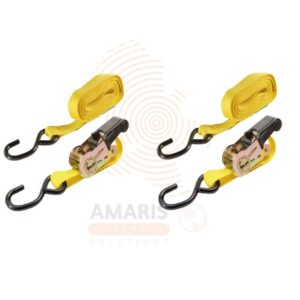Chain Block – 3ton
Whatsapp Order
A chain block, also known as a chain hoist or manual chain hoist, is a mechanical device used for lifting and lowering heavy loads. It typically consists of a chain, pulley wheels, and a lifting hook. The chain is looped around the pulley wheels, and one end of the chain is attached to a hook that can securely hold the load. The other end of the chain is usually operated by a hand chain or lever, allowing users to apply force to lift or lower the load. Chain blocks are commonly used in various industries, construction sites, and workshops for tasks that involve vertical lifting and positioning of heavy objects. They are known for their simplicity, durability, and reliability in performing lifting operations.
Rating lift weight:3Ton
Lift height:3m
Number of load chain:2
Hook to hook distance:300 mm
Chainpull to lift full load:404N
Compare
Chain Block uses
- Construction and Building Industry:
- Lifting and positioning of construction materials.
- Hoisting and installing steel beams.
- Raising and lowering equipment or tools to different levels.
- Manufacturing and Warehousing:
- Lifting and moving heavy machinery during assembly.
- Loading and unloading materials in warehouses.
- Handling and positioning large components in manufacturing processes.
- Maintenance and Repair:
- Lifting and replacing heavy parts during maintenance tasks.
- Hoisting motors or engines for repair or replacement.
- Elevating equipment for inspection and servicing.
- Shipbuilding and Maritime Applications:
- Lifting and installing ship components and machinery.
- Loading and unloading cargo onto ships.
- Positioning heavy equipment on offshore platforms.
- Mining Industry:
- Hoisting and lowering materials in mining operations.
- Lifting and transporting mining equipment.
- Supporting excavation and tunneling activities.
- Agricultural Sector:
- Lifting and moving heavy agricultural machinery.
- Handling and positioning large agricultural products.
- Assisting in construction tasks on farms.
- Utilities and Power Plants:
- Installing and maintaining electrical equipment.
- Lifting and positioning heavy components in power plants.
- Assisting in the construction and maintenance of utility structures.
- Entertainment Industry:
- Rigging and lifting stage equipment for concerts and events.
- Setting up and dismantling stage structures.
- Supporting the installation of lighting and sound systems.
- Workshops and Garages:
- Lifting and positioning vehicles for repairs.
- Hoisting heavy tools and equipment.
- Aiding in the installation of workshop machinery.
- Emergency Situations:
- Rescuing individuals trapped in confined spaces.
- Assisting in emergency response scenarios.
- Lifting and lowering materials in disaster recovery efforts.
Safety measure and precautions
- Inspection and Maintenance:
- Regularly inspect the chain block before use for any signs of damage, wear, or malfunction.
- Ensure that all parts, including chains, hooks, and pulleys, are in good condition.
- Perform routine maintenance and lubrication as recommended by the manufacturer.
- Load Capacity:
- Never exceed the rated load capacity of the chain block. Check the manufacturer’s specifications for the maximum weight it can safely lift.
- Proper Rigging:
- Ensure the load is properly rigged and securely attached to the hook.
- Use appropriate slings and attachments, and ensure they are in good condition.
- Clear Communication:
- Establish clear communication signals between the person operating the chain block and those assisting with the load.
- Use standardized hand signals or communication devices to coordinate lifting and lowering operations.
- Proper Training:
- Ensure that operators are adequately trained and familiar with the operation of the chain block.
- Only authorized and trained personnel should operate the equipment.
- Positioning and Alignment:
- Position the chain block directly above the load to ensure stability during lifting and lowering.
- Avoid side-loading, as it can compromise the integrity of the chain block.
- Avoiding Overloading:
- Never overload the chain block, and be cautious about shock loading (sudden application of force).
- Lift loads smoothly and steadily, avoiding abrupt starts and stops.
- Clear Work Area:
- Keep the work area clear of personnel and obstacles during lifting operations.
- Mark off the area to prevent unauthorized access.
- Avoiding Swinging Loads:
- Minimize swinging of the load during lifting and lowering operations to prevent accidents.
- Use taglines or guide ropes to control swinging, if necessary.
- Emergency Procedures:
- Establish and communicate emergency procedures, including how to respond to equipment malfunctions or accidents.
- Have emergency stop procedures in place, and ensure all personnel are familiar with them.
- Personal Protective Equipment (PPE):
- Use appropriate PPE, such as gloves and safety glasses, to protect against potential hazards.
- Environmental Conditions:
- Consider environmental factors such as wind, weather, and visibility when using the chain block.
- Avoid operating the equipment in adverse conditions that could compromise safety.
- Documentation:
- Keep documentation such as user manuals, load charts, and inspection records readily available.
- Document all inspections and maintenance activities.






Quincy John –
A steal for the performance
Quincy John –
Andrea –
Best deal I could find for this quality.
Andrea –